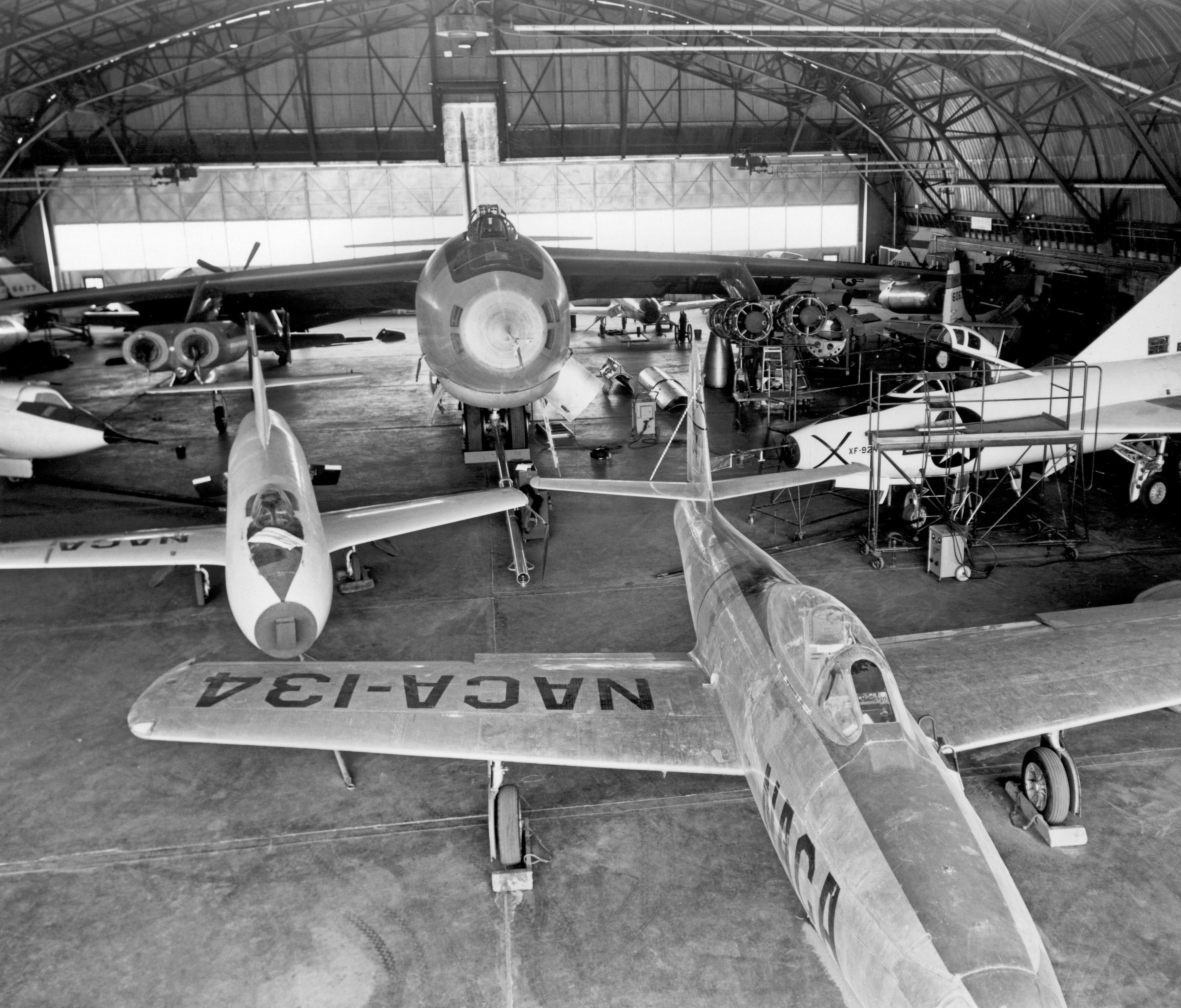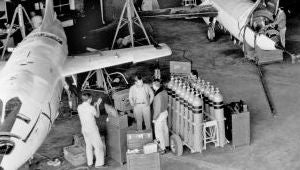 "ttyymmnn" (ttyymmnn)
"ttyymmnn" (ttyymmnn)
01/20/2015 at 10:40 • Filed to: planelopnik
 7
7
 1
1
 "ttyymmnn" (ttyymmnn)
"ttyymmnn" (ttyymmnn)
01/20/2015 at 10:40 • Filed to: planelopnik |  7 7
|  1 1 |
Before NASA, there was NACA: the National Advisory Committee for Aeronautics. Originally created 1915 to coordinate various aeronautical research projects throughout the country, NACA quickly became a leading organization in the research of aeronautics and later astronautics. The 1950s was one of the most exciting eras of aircraft development. Numerous parallel programs pushed the boundaries of flight into all new regimes of speed and altitude.

There is an enormous amount of aviation history in these two photos. They were taken at NACA's hangar at the South Base of Edwards Air Force Base in California on April 27, 1953, and show some the planes that they were using for research at the time. NASA describes the aircraft in the photo and the research being done with them.
On the left side of the hangar are the three !!!error: Indecipherable SUB-paragraph formatting!!! research aircraft. These were designed to test swept wings at supersonic speeds approaching Mach 2. The front D-558-II is the third built (NACA 145/Navy 37975). It has been modified with a leading-edge !!!error: Indecipherable SUB-paragraph formatting!!! extension. This was one of a number of wing modifications, using different configurations of !!!error: Indecipherable SUB-paragraph formatting!!! and/or !!!error: Indecipherable SUB-paragraph formatting!!! , to ease the airplane's tendency to pitch-up. NACA 145 had both a jet and a rocket engine. The middle aircraft is NACA 144 (Navy 37974), the second built. It was all-rocket powered, and !!!error: Indecipherable SUB-paragraph formatting!!! made the first Mach 2 flight in this aircraft on November 20, 1953. The aircraft in the back is D-558-II number 1. NACA 143 (Navy 37973) was also carried both a jet and a rocket engine in 1953. It had been used for the Douglas contractor flights, then was turned over to the NACA. The aircraft was not converted to all-rocket power until June 1954. It made only a single NACA flight before NACA's D-558-II program ended in 1956.
Beside the three D-558-IIs is the third D-558-I. Unlike the supersonic D-558-IIs, it was designed for flight research at transonic speeds, up to Mach 1. The D-558-I was jet-powered, and took off from the ground. The D-558-I's handling was poor as it approached Mach 1. Given the designation NACA 142 (Navy 37972), it made 78 research flights, with the last in June 1953.
In the back of the hangar is the !!!error: Indecipherable SUB-paragraph formatting!!! (Air Force 46-677). This was a Northrop-built research aircraft which tested a swept wing design without horizontal stabilizers. The aircraft proved unstable in flight at speeds above Mach 0.88. The aircraft showed combined pitching, rolling, and yawing motions, and the design was considered unsuitable. The aircraft, the second X-4 built, was then used as a pilot trainer for approach and landing studies. This data was used in designing later rocket-powered aircraft.
Almost hidden in the back of the hangar is the !!!error: Indecipherable SUB-paragraph formatting!!! (NACA 148/Air Force 44-84958). This two-seat trainer was used as a low-speed chase aircraft, as well as for support flights and liaison missions. It arrived at the NACA High Speed Flight Research Station on September 5, 1950, and was retired from NASA service after a taxi accident on April 15, 1959. The U.S. Army unit at Edwards AFB repaired the aircraft, and used it for helicopter chase work.
On the right side of the photo the !!!error: Indecipherable SUB-paragraph formatting!!! (NACA 150/Air Force 49-1900) and !!!error: Indecipherable SUB-paragraph formatting!!! (NACA 134/Air Force 45-59490) are visible. The B-47A was the first production aircraft built by Boeing. The aircraft was transferred from Langley Memorial Aeronautical Laboratory to the High-Speed Flight Research Station on March 17, 1953, where it was used for a wide range of research, including handling qualities, dynamic stability, gust loads, noise level measurements, aeroelasticity (the bending of the wings in flight), and a survey of the X-15 High Range. The !!!error: Indecipherable SUB-paragraph formatting!!! , in front of the B-47A, was used for !!!error: Indecipherable SUB-paragraph formatting!!! studies.

Turning the camera to the right side of the hangar shows the Convair !!!error: Indecipherable SUB-paragraph formatting!!! , an early experimental delta wing aircraft. Convair's research into delta wing design would lead to some of the most iconic aircraft of the 1950s: the !!!error: Indecipherable SUB-paragraph formatting!!! , !!!error: Indecipherable SUB-paragraph formatting!!! , and the !!!error: Indecipherable SUB-paragraph formatting!!!
Photos and text: !!!error: Indecipherable SUB-paragraph formatting!!! and !!!error: Indecipherable SUB-paragraph formatting!!!
 gmporschenut also a fan of hondas
> ttyymmnn
gmporschenut also a fan of hondas
> ttyymmnn
01/20/2015 at 22:58 |
|

I know its not the same thing 3:22